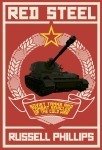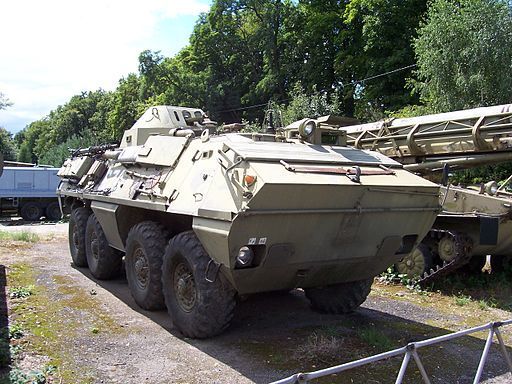Russell Phillips's Blog, page 11
June 19, 2015
Lidice Shall Live!
Last night, my wife and I went to see the Lidice Shall Live! festival at the Victoria Hall theatre in Stoke on Trent. The festival marked the destruction of Lidice, and celebrated the part of North Staffordshire miners in rebuilding the village. It was an appropriate venue – Sir Barnett Stross started the Lidice Shall Live movement in the Victoria Hall in 1942.
 My number
My numberBefore the show started, we were each given a number. It was explained that the show would start in the foyer, and we would be called into the theatre by number, just as death camp inmates would have been. Our numbers weren’t consecutive, leading us to consider what we would do if we were split up. That simple question helped us to understand a little more of what the survivors of Lidice suffered. If we were split up, we might have to be apart for an hour or two. Still, it made us think about how different that question would be in different circumstances.
The show itself was very good. It started in the foyer, with the actors playing people from Lidice going about their ordinary lives. News came of Heydrich’s death, and then soldiers started to arrive, leading the people to worry about what was happening. A particularly poignant moment was a mother telling her daughter to get dressed because they had to go to the school. Knowing the story, we knew exactly what was happening, even though they didn’t. As we were led into the theatre, we passed actors relating personal stories of Lidice survivors. It was heart-rending stuff.
The main performance was a series of dances. Each was performed by local children, with a particular theme. They were all performed well, with a great deal of energy and emotion. At the end of the second dance, the children briefly came together in a way that was reminiscent of the children’s memorial at Lidice. I was very pleased that the final dance had themes of community, solidarity, togetherness, and hope. It was good to see it end on a note of hope.
I’m really pleased that the people of Stoke on Trent have begun to remember how they helped the people of Lidice. The atrocity of Lidice should never be forgotten, nor should the miners who gave so much to help unknown strangers in a foreign land.
The post Lidice Shall Live! appeared first on Russell Phillips.
Related:
Lidice and the Unearthed Project Earlier this month, I saw a film put on by...
Lidice Unearthed Today is the 72nd anniversary of the destruction of Lidice....
Unearthed Unveiled On Saturday, my family and I joined 150-200 others at...
June 1, 2015
Win a copy of A Fleet in Being in paperback
 I’m giving away two paperback copies of A Fleet in Being. Everyone on my mailing list will be entered into the draw.
I’m giving away two paperback copies of A Fleet in Being. Everyone on my mailing list will be entered into the draw.
If you’re not already on my list, you can join here. You will also get a free ebook copy of A Damn Close-Run Thing as soon as your subscription is confirmed.
You can earn more chances to win by referring others. For each person that joins the mailing list using your referral link, you will get five extra entries into the draw. Get your referral link here.
Good luck!
The post Win a copy of A Fleet in Being in paperback appeared first on Russell Phillips.
Related:
Szent István: Hungary’s Battleship As a land-locked country with no coastline, it may come...
Large Print, Free Books, Translations I have several news items to pass on. A Damn...
A Fleet in Being: Austro-Hungarian Warships of WW1 The Kaiserliche und Königliche Kriegsmarine – The Austro-Hungarian Navy –...
May 18, 2015
AFV Alphabet: R is for Rolls-Royce Armoured Car
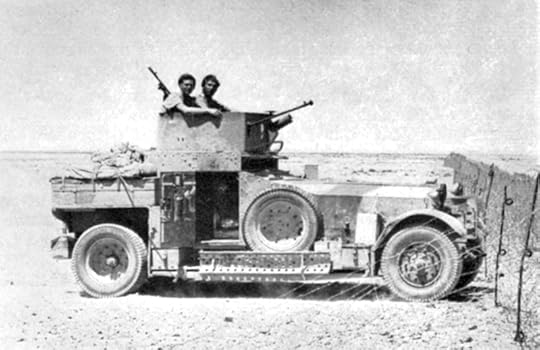
The Royal Naval Air Service (RNAS) created the first British armoured car squadron in September 1914, requisitioning all Rolls-Royce Silver Ghost chassis for the new vehicle. The design had a fully armoured body with a rotating turret, mounting a single water-cooled Vickers 0.303″ machine gun. The first vehicles were delivered in December 1914, but by then the Western Front had moved to trench warfare, which armoured cars were ill-suited for.
The RNAS formed six armoured car squadrons, each having twelve vehicles. Initially, one went to France and one to Africa to fight in the German colonies. Later, two squadrons were sent to Gallipoli. In August 1915 the RNAS squadrons were disbanded, and the material handed over to the army. The squadron in France was moved to Egypt, where the conditions were more suitable. T.E. Lawrence (more famously known as “Lawrence of Arabia”) used a squadron of nine armoured cars in his campaign against the Turks, and rated them highly, saying that they were “more valuable than rubies”.
Thirteen vehicles were given to the Irish Free State by the British government for use against the Irish Republican Army during the Irish Civil War. They were found to be very useful for convoy protection, and were used in the retaking of Waterford and Cork. They remained in service with the Irish army until 1944.
The armoured cars were modernised in 1920 and 1924, and in 1940, some vehicles had the turret replaced with an open-topped turret, mounting a Boys anti-tank rifle, Bren machine gun and smoke grenade launchers. 76 vehicles were in service with the British army when World War II broke out. They saw service in the Western Desert, Iraq, and Syria, but had been replaced by newer vehicles by the end of 1941.
The post AFV Alphabet: R is for Rolls-Royce Armoured Car appeared first on Russell Phillips.
Related:
AFV Alphabet: B is for Bishop During the western desert campaign in the early part of...
AFV Alphabet: F is for Fox Theoretically, there are many choices for “F”, since the British...
AFV Alphabet: H is for Hornet The FV1620 Humber Hornet was an early ATGM carrier, which...
May 13, 2015
Nonfiction Authors Association Interview
I’ve been interviewed by the Nonfiction Authors Association. A couple of excerpts:
What inspired you to write your book?
I’ve long had the impression that many Brits thought that the outcome of the war was a foregone conclusion, and that the Argentines weren’t a strong enemy. I feel that any suggestion that the Argentines didn’t put up a hard fight is an insult to the hundreds of men who lost their lives in the war. I wanted to write something that would show that the outcome of the war could easily have been very different.
Are there any people and/or books that have inspired you along your journey?
The first book I read after buying a Kindle was The Losing Role by Steve Anderson. It’s self-published, and an excellent book. That was the book that made me realise self-publishing was feasible, and that realisation was what started me on the path to writing a book.
Less direct inspiration came from authors like Steven Zaloga, Cornelius Ryan, and Max Hastings. They all fuelled my interest in the subject, and without that interest, I wouldn’t be writing my books.
You can read the whole interview at Member Interview with Russell Phillips, author of A Damn Close-Run Thing: A Brief History of the Falklands War
The post Nonfiction Authors Association Interview appeared first on Russell Phillips.
Related:
Interview: Glenn Dean, Soldier/Geek I recently finished reading Soldier / Geek by Glenn Dean....
Dirty Secrets: Interview with Shelley Poole Shelley Poole is the author of Lily White, a novel...
The Red Effect: Interview with Harvey Black Harvey Black is the author of the Devils With Wings...
May 5, 2015
Chernobyl Children fund raising – update

Back in February, I wrote that my son and I were going to cut off our hair to raise money for Chernobyl Children’s Project (UK), who help the children that are still suffering from the after-effects of the Chernobyl disaster. The hair cut took place in late April. We had set ourselves a target of £500, and I’m very pleased to say that we beat that, raising £600.
The Chernobyl disaster was the worst nuclear accident in history. It is one of only two classified as a level 7 event (the maximum classification) on the International Nuclear Event Scale. 31 people died during the accident itself, and over 130,000 were evacuated. The city of Pripyat, with a population of around 50,000, was abandoned. Radiation still affects people in the surrounding areas, with high levels of cancer reported.
I’m very proud of my son. If you’d like to help, the JustGiving page is still open to donations.
The post Chernobyl Children fund raising – update appeared first on Russell Phillips.
Related:
Shilka: The ZSU-23-4 The ZSU-23-4 entered service in 1966, as a replacement for...
Red Steel: Soviet Tanks and Combat Vehicles of the Cold War The Cold War never heated up, but if it had,...
The Bear Marches West: 12 Scenarios for 1980s NATO vs Warsaw Pact Wargames NATO kept the Warsaw Pact behind the Berlin Wall until...
May 4, 2015
AFV Alphabet: Q is for Al-Qaswa Logistics Vehicle
I have to admit that finding an entry for Q was a challenge, and as it is, I haven’t been able to find a picture of the Al-Qaswa under a licence that allows me to use it here. There are some good pictures on the PakDef Military Consortium site, however.
The Al-Qaswa is a tracked vehicle with a fully enclosed armoured crew compartment, and an open cargo bed to the rear. It is based on a lengthened M113P chassis, with an extra road wheel on each side, sharing many components with the M113P. Rather than an armoured personnel carrier used to carry supplies, it is specifically designed to transport supplies across all types of terrain. It is designed and built by Heavy Industries Taxila (HIT) in Pakistan.
It has a crew of two, and can carry up to six tons of cargo. A tarpaulin can be used to protect the cargo from inclement weather. HIT suggest that the vehicle could form the basis for a number of further vehicles, such as a missile launcher, ambulance, command vehicle, etc.
The post AFV Alphabet: Q is for Al-Qaswa Logistics Vehicle appeared first on Russell Phillips.
Related:
AFV Alphabet: E is for EIFV The EIFV is the Egyptian Infantry Fighting Vehicle, an interesting...
AFV Alphabet: A is for Antonov A-40 Inspired by Tim Gow’s A to Z of Wargaming series...
AFV Alphabet: G is for Gvozdika The 2S1 Gvozdika self-propelled 122mm howitzer was accepted for service...
April 24, 2015
Wargame Vault Deal of the Day: Red Steel
Red Steel is the Wargame Vault deal of the day. It’s available at a massive 80% off for the next 24 hours. Get it now
The post Wargame Vault Deal of the Day: Red Steel appeared first on Russell Phillips.
Related:
New Book: Red Steel My latest book, “Red Steel: Soviet Tanks and Combat Vehicles...
Shilka: The ZSU-23-4 The ZSU-23-4 entered service in 1966, as a replacement for...
Red Steel: Soviet Tanks and Combat Vehicles of the Cold War The Cold War never heated up, but if it had,...
April 20, 2015
AFV Alphabet: P is for Pig

The Pig was a simple wheeled armoured personnel carrier, created by fitting an armoured body to a four-wheel drive 1-ton Humber truck. It was intended to be used only as an interim vehicle, until purpose-built APCs were available. However, when the British Army was deployed to Northern Ireland at the start of the Troubles, some form of armoured transport vehicle was needed. The Pig was deemed ideal for this purpose, since it in no way resembles a tank – it simply looks like what it is, an armoured truck.
As the Troubles continued, a Mark II version of the Pig was introduced. This had improved armour and heavy duty bull bars for breaking through barricades. Other specialised variants were created for use in Northern Ireland: the “Flying Pig” had fold-out riot screens on the sides and roof. The “Holy Pig” had a roof hatch surrounded by a perspex screen. The “Kremlin Pig” had wire screens for protection against shaped charges (particularly the RPG-7). The “Squirt Pig” was fitted with a water cannon. The “Foaming Pig” had a foam generator to minimise the effect of explosive devices. The “Felix Pig” was modified for use by use by Explosive Ordnance Disposal (EOD) teams.
The Pig was also used as the base vehicle for the Hornet, an earlier entry in this series.
The post AFV Alphabet: P is for Pig appeared first on Russell Phillips.
Related:
AFV Alphabet: F is for Fox Theoretically, there are many choices for “F”, since the British...
AFV Alphabet: H is for Hornet The FV1620 Humber Hornet was an early ATGM carrier, which...
AFV Alphabet: D is for Deerhound “T17-Deerhound-armored-car-2“. Licensed under Public domain via Wikimedia Commons. The T17...
April 6, 2015
AFV Alphabet: O is for OT-64
The OT-64 is a wheeled armoured personnel carrier, developed in the late 1950s and early 1960s as a joint project between Poland and Czechoslovakia. It is similar in concept and design to the Soviet BTR-60, but with some important differences. The OT-64 had overhead armour protection, had twin rear doors for entry and exit, and was powered by a single diesel engine. Like the BTR-60, it was air-portable and amphibious.
The original versions were not armed, but were later equipped with 7.62mm or 12.7mm machine guns, some with an armoured shield fitted around the machine gun. These early models could carry 18 men in addition to the two crew. The later OT-64A was fitted with a small turret, mounting 14.5mm and 7.62mm machine guns. Later, some vehicles had the 14.5mm machine gun replaced with a 12.7mm NSV anti-aircraft machine gun. The turret reduced the troop carrying capacity to eight.
All models were fitted with NBC protection, night vision equipment, and a central tyre pressure regulation system, allowing the driver to control tyre pressure whilst driving. They have a top speed of around 60mph, and a range of 440 miles.
The post AFV Alphabet: O is for OT-64 appeared first on Russell Phillips.
Related:
AFV Alphabet: G is for Gvozdika The 2S1 Gvozdika self-propelled 122mm howitzer was accepted for service...
AFV Alphabet: H is for Hornet The FV1620 Humber Hornet was an early ATGM carrier, which...
AFV Alphabet: I is for Infanterikanonvagn 91 “Ikv 91 a” by Mats Persson – Own work. Licensed...
March 31, 2015
Crisis Point IV – Return to Andreivia
Over the weekend, I played in my second Crisis Point game (Crisis Point IV), organised by Richard Crawley.
This year, I played the Russians (I’d planned to play the Russians last year, but due to last-minute changes, I played the Andreivian Turks instead). Mark Kniveton provided much of the Russian forces, and was my co-commander. On day 1, we had a force of naval infantry that were trying to break out of a small beachhead on the coast at Mdinar. We were opposed by Andreivian government forces, ably commanded by Ian Shaw.
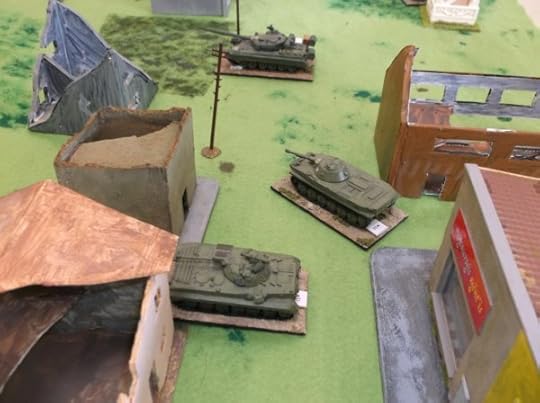
Russian forces heading out of Mdinar
The light armoured vehicles didn’t get far out of the town before being destroyed by the government forces. The government’s hotch-potch of vehicles (BMP-1s, emplaced T-34/85 turrets, and a T-62) were able to make short work of the Russian BMP-2s, BRDM-2 and PT-76. The supporting armour (a platoon of T-80s) fared better, but were wary of advancing too close to the enemy infantry without their own infantry support.
Even government air strikes and reinforcements (in the form of a platoon of JS-IIIs) couldn’t stop the relentless Russian armour. When the light faded, the government forces used the cover of darkness to retreat. This allowed the naval infantry to head to the airport to support the VDV that had previously captured it, in their effort to take the bridges leading to Tcherbevan.
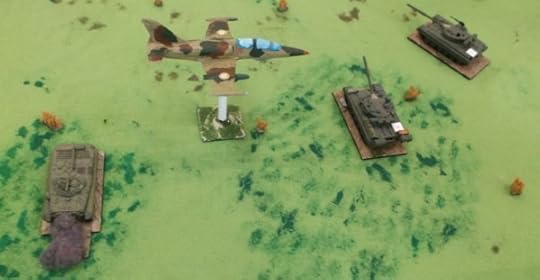
The Andreivians call in the air force
On day 2, Mark and I commanded the VDV forces that had previously secured Tcherbevan International Airport. We had orders to take the bridges leading to the city centre. With a platoon of BMDs and a pair of ASU-85s, we set out to extend the hand of friendship and offer support. We were, after all, in the country to offer help to a neighbour.

VDV offer the hand of friendship, backed up by a BMD and an ASU-85
We soon discovered that the railway marshalling yards were home to a band of fanatics in government uniforms. Unsure whether or not they had anti-tank weapons, the armour held back, providing supporting fire to the brave paratroopers as they charged in.
The fanatics called for air support from the Andreivian government. On the previous day, a Russian Su-25 Frogfoot had been driven off by Andreivian air defenses. Today, a well-aimed SA-7 missile from a brave Russian paratrooper shot the Andreivian Jaguar down. Being fanatics, most of the defenders refused to run, and stayed their ground until they were over-run and captured.
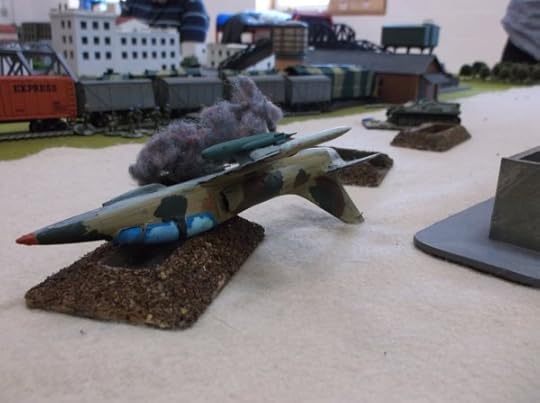
Andreivian government air support
Elsewhere, NATO had also called in air support. Realising the awesome efficacy of the Russian air defences, they first reached an agreement with the Russians. Thanks to this agreement, their aircraft and helicopters were able to continue their mission without hinderance.

NATO air support
The government provided further support, in the form of a Type 61 tank on the far side of the river and a gunboat mounting a T-34/85 turret. These proved rather more effective than the air support, destroying a BMD.

Andreivian reinforcements
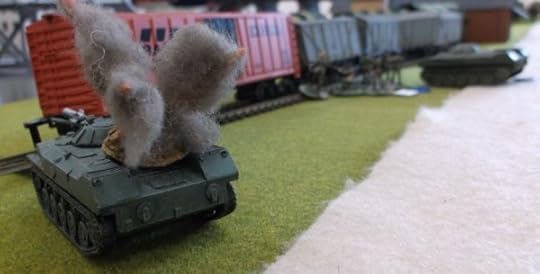
A BMD is destroyed
By the end of the game, the railway marshalling yards had been cleared of fanatics. VDV troopers had taken possession of one end of one bridge.
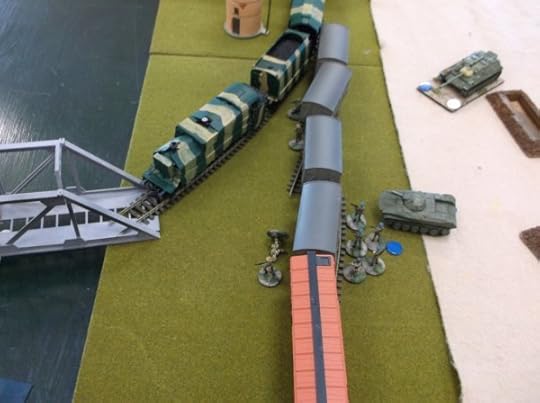
Russian paratroopers clear the marshalling yards
Like last year, it was an excellent weekend. The gaming was fun, and the food at the local pub (the Royal Hotel) was both excellent and plentiful. My thanks to everyone involved. Hopefully I will see you all next year 
The post Crisis Point IV – Return to Andreivia appeared first on Russell Phillips.
Related:
Battle for Tcherbevan: Crisis Point III Recently, I played in Crisis Point III, a large, weekend-long...
The Great SOTCW Giveaway The Society of Twentieth Century Wargamers is pleased to announce...
RIP Donald Featherstone I’ve just heard that Donald Featherstone died yesterday. For those...

